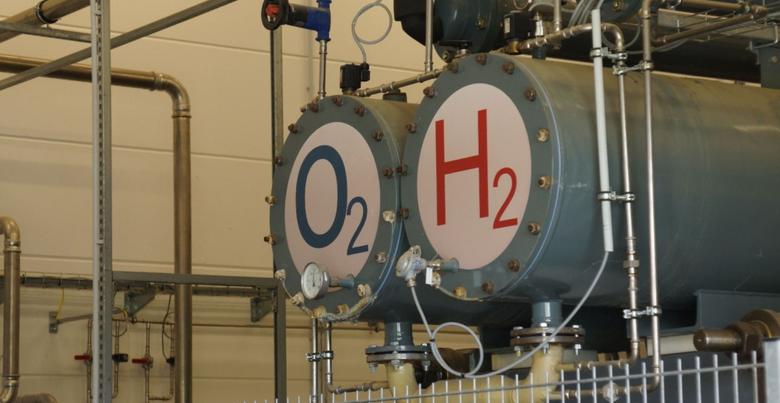
HYDROGEN FOR GERMANY: €7 BLN

DW - As part of its economic stimulus package, Berlin wants to expand the role of green hydrogen to help end its reliance on coal. Despite €7 billion being earmarked, there's no agreement on how it will be spent.
Hydrogen, the universe's most abundant particle, has often been touted as a way to power vehicles and energy plants, but it is just too expensive. Most hydrogen used today is produced by reforming natural gas, which also releases a lot of carbon dioxide (CO2). Green hydrogen, on the other hand, is extracted from water by electrolysis, but it is still a very energy-intensive process.
Hydrogen's huge advantage, however, is that can be more easily stored than other forms of renewable energy and for longer periods of time, which is why it is a key part of Germany's energy transition (Energiewende) strategy, as Europe's No.1 economy seeks to become carbon neutral by 2050. Last week, the Berlin government said it aimed to have 5 gigawatts (GW) of hydrogen production capacity by 2030, with another 5 GW a decade later.
The proposal, which could see hydrogen eventually make up about 10% of the country's total electricity capacity, was unveiled as part of a €130 billion ($147 billion) stimulus to help reboot the economy in the wake of the coronavirus pandemic. The hydrogen commitment is part of some €40 billion earmarked for climate-related spending.
Hydrogen strategy still not firmed up
Ministers, however, still haven't agreed on a strategy for the rollout of hydrogen, so while the cash has been welcomed, the energy sector and environmental groups remain in the dark over exactly how it will be spent.
"There are still a lot of unanswered questions about how hydrogen production in Germany will be powered," Michael Schäfer, senior advisor at the Berlin-based think-tank Agora Energiewende, told DW.
For the production of water-extracted hydrogen to be a mostly carbon-free process, it will require a massive ramp-up in wind and solar energy production. Only once renewable energy production is accelerated can green hydrogen be deployed in power stations plus heavy industrial processes and to replace gas and oil in the heating and transport sectors.
"The problem is that Germany's renewable production is lagging, and the one thing that is missing in the [government's] recovery package is a plan to accelerate the production of other renewable energy (like wind farms)," Schäfer added.
Wrangling continues within the grand coalition over exactly how much production capacity should be allotted to hydrogen. The center-left SDP wants the government to commit to 10 MW a decade earlier than Chancellor Angela Merkel's conservatives.
Renewable imports required
Economy Minister Peter Altmaier has said it will not be possible to produce enough hydrogen from renewables domestically and an import industry must be built up from wind and solar-power intensive nations to achieve CO2 targets.
Schäfer noted that in addition to the €7 billion earmarked for green hydrogen in Germany, the government stimulus included plans to spend a further €2 billion to build up partnerships with other countries.
"We need a European collaboration on hydrogen, which when combined with the renewables capacity of countries in the European south, could help Germany achieve its renewables requirements," he told DW.
Meanwhile, German states are already gearing up to welcome new green hydrogen facilities. The northern city state of Hamburg, for example, announced plans in September to become home to the world's largest hydrogen electrolysis plant with a capacity of 100 megawatts.
The southern state of Bavaria, meanwhile, has set up a hydrogen research center and has roped in carmakers Audi and BMW, along with Siemens and energy supplier Bayernwerk.
Hydrogen grid announced
German gas pipeline operators, earlier this year, revealed the blueprint for the world's largest hydrogen grid, which would cover around 5,900 kilometers (3,666 miles). Details about the first section (when ready in 2030, it will be some 1,200-kilometers in length) were released last month. Only 100 kilometers of the first stage would need to be built, with the rest being converted former gas pipelines, according to the grid operations' association FNB Gas.
FNB Gas said the H2 Startnetz 2030 would allow some 30 specific green gas projects identified in northern Germany to connect with key areas for green hydrogen demand in the states of North Rhine-Westphalia and Lower Saxony. The network is expected to cost €660 million and will eventually link to the Netherlands, which aims to have 30%-50% of its energy generated by decarbonized gas by 2050.
Despite the hype around green hydrogen, last year, a report by the International Renewable Energy Agency (Irena) warned that the fuel "should not be considered a panacea." It said that hydrogen would still likely "trail other strategies" for carbon-free energy due to the cost of production and would only have very targeted applications.
-----








